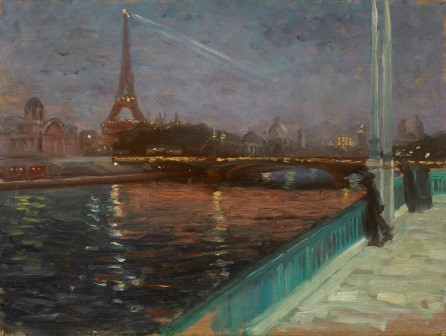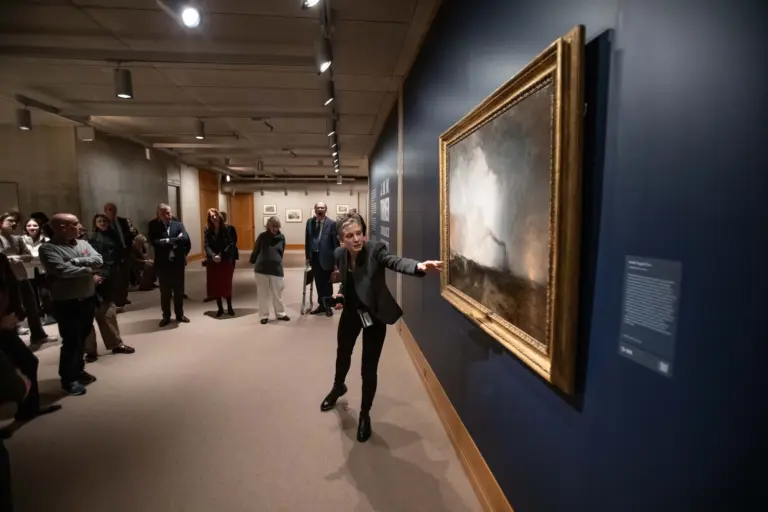

Alfred Maurer (American, 1868-1932)
Nocturne, Paris, n.d.
Oil on board, 10 1/4 x 13 3/4 in.
Avery Galleries, Bryn Mawr, Pennsylvania
Courtesy of Avery Galleries
By Chéye Roberson
Sentinel Correspondent
Curators at the Bruce Museum will shed light on the milestones of 19th century Paris’ artists and scientists by showing how their creations have contributed to the illumination of our modern world. The Bruce’s “Electric Paris” and “Electricity” exhibits will run through the summer.
“I think having the art exhibit in concert with the science exhibit people come away with a better understanding of history and science impacted visual arts,” said Margarita Karasoulas, curator of “Electric Paris.”
The exhibit focuses on the artwork of French, Russian, and American painters who depicted Paris in natural and artificial light to examine the ways in which art was affected by the transition from oil and gas fueled light to electric light. “Electric Paris” runs through September 4 and includes 50 works.
 Curran
Curran
Charles Courtney Curran (American, 1861-1942)
Paris at Night, 1889
Oil on panel, 9 1/16 x 12 1/4 in.
Terra Foundation for American Art, Daniel J. Terra Collection, 1989.12
Photography ©Terra Foundation for American Art, Chicago
“Electricity,” developed by the Franklin Institute and curated by Daniel Ksepka, the science curator at the Bruce, displays several interactive examples of the machines that inventors have used to harness the power of electricity, such as plasma tubes, jumping rings, a solenoid, and Jacob’s ladder. The concurrent exhibits make it clear just how much art and science have influenced each other.
“You can talk about static electricity, but it’s much more fun to show a classic plasma sphere,” said Ksepka. “We included things that you can interact with as examples of how we transmit power and good ways to teach how we use electricity and power throughout our day—just about everything we use is electricity. We don’t think about it in our daily lives.”
Both exhibits give visitors an idea of how many contributors were involved in the evolution of electrical lighting. “Most people always think of Edison inventing the light bulb, but there were millions of people who were continuously tinkering that lead to being able to install electricity,” Ksepka said.
Each of the exhibits will include special presentations. The Belle Époque Film Series explores life in Paris at the turn of the century, and will be shown on Wednesday mornings at 10:30 a.m.
During the “Bruce Goes Electric” Young Professionals Happy Hour on May 26, 5:30 p.m. to 8 p.m., the museum’s galleries will be open late and museum staff will be on hand to give informal tours of the exhibitions on view, including “Electric Paris,” “Electricity,” “Wild Reading” and “Mianus Gorge.”
 Butler
Butler
Theodore Earl Butler (American, 1860-1936)
Place de Rome at Night, 1905
Oil on canvas, 23 1/2 x 28 3/4 in.
Terra Foundation for American Art, Daniel J. Terra Collection
Photography ©Terra Foundation for American Art, Chicago
Speaking of happy hour, the advancements in electrical technology at the turn of the century made it possible for people to see their social lives in a new light.
“Lighting had a profound effect on how people were able to see the city. More people were able to walk around at night, unlike before. It created a night life,” said Karasoulas.
 Metcalf
Metcalf
Willard Metcalf
(American, 1858-1925)
Au Café, 1888
Oil on panel, 19 11/16 x 12 1/4 in.
Terra Foundation for American Art, Daniel J. Terra Collection, 1992.10
Photography ©Terra Foundation for American Art, Chicago
The Arts and New Technologies Graduate Student Symposium, where four doctoral students will discuss how art from various periods of history responded to advances in technology, will take place on June 19 from 1 to 4 p.m.
“The Electrical Panel: A Live Interactive Conversation” is scheduled for May 24, and a lecture called “Robots that Teach,” highlighting advances in building supportive robots for teaching skills to children, is set for June 14.
“Lectures on Electric Modernism” on June 8, 6 to 8 p.m., will feature Sarah Kennell, the curator of photography at the Peabody Essex Museum, and on June 23, also 6 to 8 p.m., will feature Sandy Isenstadt, a professor of modern architecture history at the University of Delaware.
“We’ve brought experts into the museum to take questions from the audience,” said Ksepka. “We have a mix of historians from historical professions and applied science.”
Ksepka said that the parallel exhibits highlight what is most distinct about the Bruce Museum.
“I just think it’s wonderful to combine art and science for this exhibit. You can see the effect science has on art—there’s a wonderful message there,” said Ksepka. “There are a lot of art and a lot of natural history museums, and we’re both and very proud of that.”
 Sargent
Sargent
John Singer Sargent (American, 1856-1925)
In the Luxembourg Gardens, 1879
Oil on canvas, 25 7/8 x 36 3/8 in.
Philadelphia Museum of Art:
John G. Johnson Collection, 1917, Cat. 1080
Courtesy of the Philadelphia Museum of Art



